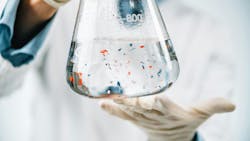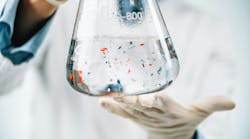Can membranes help remove microplastic from drinking water?
Key Highlights
- Microplastics are found in 81% of water samples worldwide, with U.S. tap water being among the most contaminated sources.
- Sources include environmental pollution, synthetic textiles, tires and packaging, contributing to microplastic presence in water and ecosystems.
- Membrane technologies like ultrafiltration and reverse osmosis show promise in removing microplastics, but challenges like fouling and maintenance remain.
Microplastics are plastic pieces less than 5 millimeters long and found in drinking water, the environment and the body. Research from Penn State University environmental chemist Sherri Mason and her colleagues found them in 81% of 159 water samples from 14 countries. They determined that tap water from the United States was most contaminated, containing 9.24 particles per liter. As consumers learn more, many want to know how to remove microplastics from drinking water.
Scientists are still learning about the human health impact, but recent research has found these shards deep inside bones and linked them to chronic disease and behavioral changes. Conventional removal methods fall short because of particle size, ubiquity and sources, from synthetic textiles to tires. Research suggests membranes remove microplastics with sufficient effectiveness to warrant further study.
The current understanding of microplastics in drinking water
Some microplastic sources stem from environmental issues researchers have known about for decades. More than 1 million animals die every year after becoming tangled in litter. Some plastic containers, wrappers and similar products that trap them break apart and become microplastics.
Polyester clothing also sheds microplastics when people wash it, and detergents and dryer sheets often contain microplastics. Tires and brake pads are other significant culprits, producing the particles through use. Even when people hear about these contaminants and try to cut down on single-use plastic, progress is not as easy as it initially seems. Paper cups often have the material as a lining, and reusable bottles can add microplastics to the contents.
Besides the potentially high concentrations in tap water, researchers have discovered notable issues in surface water. A 2024 study of Maine’s Frenchman Bay showed approximately 400 billion microplastic fibers on its surface and indicated it contains 1.8 fibers per liter on average.
Microplastics are tiny, have nonuniform shapes and come from many places, increasing removal-related challenges. Membrane-based efforts could help concerned parties make headway.
Membrane technologies for microplastic removal
Membranes remove microplastics by capturing the particles in their pores. The main methods include:
Microfiltration: This filtration technology uses polymer membranes to remove bacteria and suspended solid particles larger than 0.1 microns from liquid. The larger pore sizes with this method make other options better suited for addressing microplastics.
Ultrafiltration: Ultrafiltration removes everything microfiltration can, plus viruses. It requires a higher pressure than microfiltration, but the force can come from water taps. These membranes’ pore sizes of 0.01 microns make them catch more contaminants than microfiltration methods.
Nanofiltration: These membranes have pore sizes of 0.001 microns. Industrial professionals often use them to filter water with low quantities of total dissolved solids or to remove organic matter.
Reverse osmosis: Reverse osmosis membranes rely on semipermeable materials and water pressure to allow the passage of purified liquid but not contaminants. The pore sizes of 0.0001 microns make them highly effective in filtering out microplastics, as long as people maintain the systems correctly.
Although some membrane technologies work well for microplastic removal, downsides make implementing them challenging. Fouling is one of the most common issues that reduces overall efficiency. A 2022 industrial study found that investing in antifouling membranes becomes more cost-effective over time, even though cheaper alternatives exist. People removing microplastics at home typically do not have numerous options for replacement supplies and must purchase the accessories intended for their purchased systems.
Consumers wanting to remove microplastics from drinking water with membranes may not understand or follow the correct maintenance steps, including replacing the filters at the recommended intervals and tracking their overall usage. Depending on their chosen method, some may find it unsuitable for their residences. Some systems require minor modifications to existing plumbing, which could violate renters’ tenancy agreements.
Filtration methods may take longer to purify water than people expect, necessitating adjustment periods and changed behaviors, especially in households where people have become used to instantly available water.
Experimental advances in membrane design
Researchers have discovered how to improve membrane functionality, such as by using enhanced materials to boost their filtration and separation capabilities. Some promising work involves composite materials made from polyethersulfone and titanium dioxide nanoparticles. Studies also indicate that combining ultrafiltration membranes with coagulation pretreatment prevents fouling, making the filtration results more effective and easier to maintain.
Because microplastics have varied shapes and come from many sources, professionals interested in improving how membranes remove microplastics should continue accounting for that diversity and assess how to maximize performance despite it.
A 2022 study indicates confirmed effectiveness does not always extend to all microplastic sizes and types. It found that integrated membrane systems usually removed more than conventional activated sludge, but they worked less well when removing the smallest pieces.
Household and point-of-use applications
Some companies and researchers have developed consumer-facing and point-of-use applications to filter microplastics. They typically include activated carbon, microfiltration or ion-exchange systems.
LifeStraw is a readily available brand that uses a membrane microfilter that blocks particles and pathogens larger than 0.2 microns or an ultrafilter that stops contaminants at least as small as 0.02 microns. The brand’s blog posts on its website mention that internal testing demonstrates that these technologies remove 99.999% of microplastics from drinking water.
Product development teams also have much to learn from existing point-of-use filtration systems that perform well in demanding conditions. When MECO received a five-year contract to produce lightweight water purifiers for soldiers in the United States Army, the company created an advanced mobile unit that eliminates biological, chemical and nuclear agents from water. Someone can set it up in 45 minutes and operate it alone, making it ideal for supporting armed forces. MECO has also deployed these filters to assist in disaster relief efforts.
Practical implications for drinking water safety
Consumers interested in how membranes remove microplastics should read product specification sheets before purchasing specific systems. Some may also feel more at ease by visiting their local utilities’ websites to learn which steps those entities take to reduce microplastics in drinking water. Professionals in customer-education roles within the water industry should consider suggesting that their employers create topic hubs to help people find reliable, science-based information about microplastics and what they can do to minimize their exposure.
People feeling anxious due to hearing new findings about microplastics should be careful to keep balanced perspectives and not take drastic measures, such as reducing their water intake. That decision could result in health problems by causing dehydration.
Some home-testing companies offer kits that allow people to test their blood for microplastics. One environmental writer who did felt initially alarmed because the results showed 39 pieces of plastic in her small sample. The testing provider also contextualized the information by saying the tester had more microplastics in her blood than 77% of those who had also submitted samples.
Experts commenting on the matter said the data may not mean much due to the difficulty of getting reliable and reproducible results at home. Microplastics could also contaminate the sample if people make mistakes when collecting or processing it. This illustrates why consumers should remain cautious before testing themselves or recommending that others do.
Challenges and limitations
Successful attempts to remove microplastics from drinking water may interest people in budgeting for membrane-based systems. They will develop the most realistic expectations by understanding how to tackle the membrane fouling and clogging that inevitably occurs through use. Researchers will gradually discover new ways to target these issues, but the most practical preventive steps are to follow the manufacturers’ instructions for maintaining and replacing the filters.
Economic barriers also exist because not all consumers can afford water purification systems. Getting results may not require extensive spending. One study found that boiling water for five minutes eliminated 25%-90% of free-floating nano- and microplastics. The overall effectiveness depended on the milligrams of calcium carbonate per liter.
Even so, the lack of standardized monitoring protocols makes it virtually impossible for residents without the relevant, specialized training to confirm whether their filtration systems get the desired results.
Future directions
Although research shows membranes remove microplastics from drinking water, inherent challenges make them inaccessible for many residents interested in them. Ongoing work to improve materials and reduce fouling will help, as will municipal processes that combine membranes with other treatment steps. Regulatory standards and consistent monitoring methods will also elevate accuracy and highlight progress.
About the Author
Emily Newton
Emily Newton is the editor in chief of Revolutionized, a popular science publication that dives into the latest innovations in science, technology and industry.

